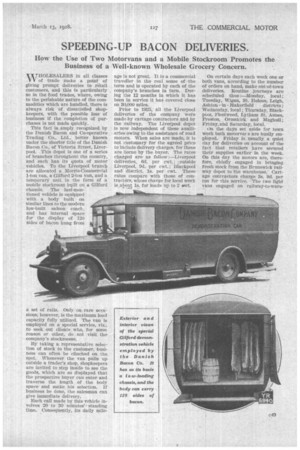SPEEDING-UP BACON DELIVERIES.
Page 79

Page 80

If you've noticed an error in this article please click here to report it so we can fix it.
How the Use of Two Motorvans and a Mobile Stockroom Promotes the Business of a Well-known Wholesale Grocery Concern.
WHOLESALERS in all classes of trade make a point of giving prompt deliveries to idtail customers, and this Is particularly so in the food trades, where, owing to the perishable nature of the commodities which are handled, there is always risk of dissatisfied shopkeepers, with the possible loss of business if the completion of purchases is not made quickly.
This fact is amply recognized by the Danish Bacon and Co-operative Trading Co., Ltd., better known under the shorter title of the Danish Bacon Co., of Victoria Street, Liverpool. This depot is one of a series of branches throughout the country, and each has its quota of motor vehicles. To the Liverpool brancb are allocated a Morris-Commercial 1-ton van, a Gilford 2-ton van, and a temporary unit in the fOrrn of a mobile stockroom built on a Gilford chassis. The last-mentioned vehicle is equipped with a body built on similar lines to the modern low-built saloon coach, and has internal space for the display Of 120 sides of bacon hung from a set of rails. Only on rare occasions, however, is the maximum load capacity fully utilized. The van is employed on a special service, viz., to seek out clients who, for some reason or other, do not visit the company's stockrooms.
By taking a representative selection of stock to the customer, business can often be clinched on the spot. Whenever the van pulls up outside a trader's shop, shopkeepers are invited to step inside to see the goods, which are so displayed that the prospective buyer can enter and traverse the length of the body space and make his selection. If business be done, the salesman can give immediate delivery.
Each call made by this vehicle involves 20 to 30 minutes' standing time. Consequently, its daily mile
age is not great. It is a commercial traveller in the real sense of /the term and is operated by each of the company's branches in turn. During the 12 months in which it has been in service it has covered close on 30,000 miles.
Prior to 1925, all the Liverpool deliveries of the company were made by cartage contractors and by the railway. The Liverpool depot is now independent of these auxintirieS owing to the assistance of road motors. When sales are made, it is not customary for the agreed price to include delivery charges, for these are borne by the buyer. The rates charged are as follow :—LiverpOol deliveries, 6d. per cwt.; ,,,outside Liverpool, 9d. per cwt.; Blackpool and district, 1s. per cwt. These rates compare with those of contractors, whose charge for local work is,about is. for loads up to 2 awt, On certain days each week one or both vans, according to the number of orders on hand, make out-of-town deliveries. Routine journeys are scheduled thus :—Monday, local ; Tuesday, Wigan, St. Helens, Leigh,
Ashtouin -Makerfield districts; Wednesday, local; Thursday, Blackpool, Fleetwood, Lytham St. Annes, Preston, Orms kirk and Maghull ; Friday. and Saturday, local.
On the days set aside for town work both motorvar s are busily employed. Friday is usually a quiet day for deliveries on account of thefact that retailers have secured their supplies earlier in •the week. On this clay the motors are, therefore, chiefly engaged in bringing fresh stock from the Brunswick railway depot to the warehouse. Cartage contractors charge 3s. 9d. per ton for this service. The two light vans engaged on railway-to-ware
house consignments will clear in the course of an ordinary working day -atleast 12 tons of bacon.
The vans commence work at about 8 30 each morning, and when on delivery worK they are loaded at 1h Victoria Street warehouse. The Morris-Commercial van takes a load of 30 cwt. of bacon (about 60 sides) and the Gifford about 23, tons (90 to 300 sides). The warehouseman by whom the goods are checked out to the vanmen has a complete list of orders for delivery, And prepares the consignments in separate stacks. The driver sunerintends the loading of his vehicle, and goods are so arranged that the bacon to he delivered first is nearest the van doors.
The number of calls made varies from 5 to 30 per day for each van, according to the journey made; but during an average week the two motors undertake about. 300 deliveries. . When engaged on local work, the number of halts per, day militates against big.mileages, which average about 30 per clay. On the Blackpool and . Fleetwood journeys the day's mileage is abotit 130. From 20 to 30 tons of bacon arc delivered each .week by the two motors.
No details of actual running costs are available, but it is estimated that the operating expenses. of the Morris-Commercial 1-ton van and the Gilford 2-tonner are about 112 per week, including the cost of petrol and oil and drivers' wages. All ordinary running repairs are undertaken by the drivers. Incidentally, he petrol return cf. the Gilford is about 15 m.p.g. and of the MorrisCommercial tonner 18-20 m.p.g. Some wholesaieijs contend that the best type of hoy for the wholesale bacon trade i the open' lorry with a framework to take a loose waterproof cover, for the reason that the vehicle mo e often than not can be loaded from overhead hoists at the warehouses. • It would appear from these opinions that the sliding 'tilt might meet with much popularity in this sphe're of use. On the other hand, theenclosed van has its compensating features in that • the sides can be used for advertising purposes.




























































































































